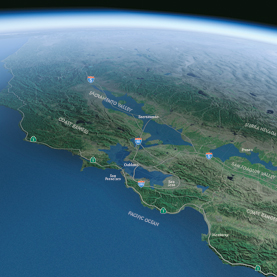
Megastorms Could Drown Massive Portions of California
- Nov 30, 2012
Nov 30, 2012 - scientificamerican.com
Huge flows of vapor in the atmosphere, dubbed "atmospheric
rivers," have unleashed massive floods every
200 years, and climate change could bring more of
them
By Michael D. Dettinger and B. Lynn Ingram

DROWNED:
A 43-day atmospheric-river storm in 1861 turned
California’s
Central Valley region into an inland sea, simulated
here on a current-day map.
Image: Don Foley
Editor's note (11/30/12): The article will appear
in the January 2013 issue of Scientific American.
We are making it freely available now because of
the flooding underway in California.
The intense rainstorms sweeping in from the Pacific
Ocean began to pound central California on Christmas
Eve in 1861 and continued virtually unabated for
43 days. The deluges quickly transformed rivers running
down from the Sierra Nevada mountains along the state’s
eastern border into raging torrents that swept away
entire communities and mining settlements. The rivers
and rains poured into the state’s vast Central
Valley, turning it into an inland sea 300 miles long
and 20 miles wide. Thousands of people died, and
one quarter of the state’s estimated 800,000
cattle drowned. Downtown Sacramento was submerged
under 10 feet of brown water filled with debris from
countless mudslides on the region’s steep slopes.
California’s legislature, unable to function,
moved to San Francisco until Sacramento dried out—six
months later. By then, the state was bankrupt.
A comparable episode today would be incredibly more
devastating. The Central Valley is home to more than
six million people, 1.4 million of them in Sacramento.
The land produces about $20 billion in crops annually,
including 70 percent of the world’s almonds—and
portions of it have dropped 30 feet in elevation
because of extensive groundwater pumping, making
those areas even more prone to flooding. Scientists
who recently modeled a similarly relentless storm
that lasted only 23 days concluded that this smaller
visitation would cause $400 billion in property damage
and agricultural losses. Thousands of people could
die unless preparations and evacuations worked very
well indeed.
Was the 1861–62 flood a freak event? It appears
not. New studies of sediment deposits in widespread
locations indicate that cataclysmic floods of this
magnitude have inundated California every two centuries
or so for at least the past two millennia. The 1861–62
storms also pummeled the coastline from northern
Mexico and southern California up to British Columbia,
creating the worst floods in recorded history. Climate
scientists now hypothesize that these floods, and
others like them in several regions of the world,
were caused by atmospheric rivers, a phenomenon you
may have never heard of. And they think California,
at least, is overdue for another one.
Ten Mississippi Rivers, One Mile High
Atmospheric rivers are long streams of water vapor
that form at about one mile up in the atmosphere.
They are only 250 miles across but extend for thousands
of miles—sometimes across an entire ocean basin
such as the Pacific. These conveyor belts of vapor
carry as much water as 10 to 15 Mississippi Rivers
from the tropics and across the middle latitudes.
When one reaches the U.S. West Coast and hits inland
mountain ranges, such as the Sierra Nevada, it is
forced up, cools off and condenses into vast quantities
of precipitation.
People on the West Coast of North America have long
known about storms called “pineapple expresses,” which
pour in from the tropics near Hawaii and dump heavy
rain and snow for three to five days. It turns out
that they are just one configuration of an atmospheric
river. As many as nine atmospheric rivers hit California
every year, according to recent investigations. Few
of them end up being strong enough to yield true
megafloods, but even the “normal” storms
are about as intense as rainstorms get in the rest
of the U.S., so they challenge emergency personnel
as well as flood-control authorities and water managers.
Atmospheric rivers also bring rains to the west
coasts of other continents and can occasionally form
in unlikely places. For example, the catastrophic
flooding in and around Nashville in May 2010—which
caused some 30 deaths and more than $2 billion in
damages—was fed by an unusual atmospheric river
that brought heavy rain for two relentless days up
into Tennessee from the Gulf of Mexico. In 2009 substantial
flooding in southern England and in various parts
of Spain was also caused by atmospheric rivers. But
the phenomenon is best understood along the Pacific
Coast, and the latest studies suggest that these
rivers of vapor may become even larger in the future
as the climate warms.

|



